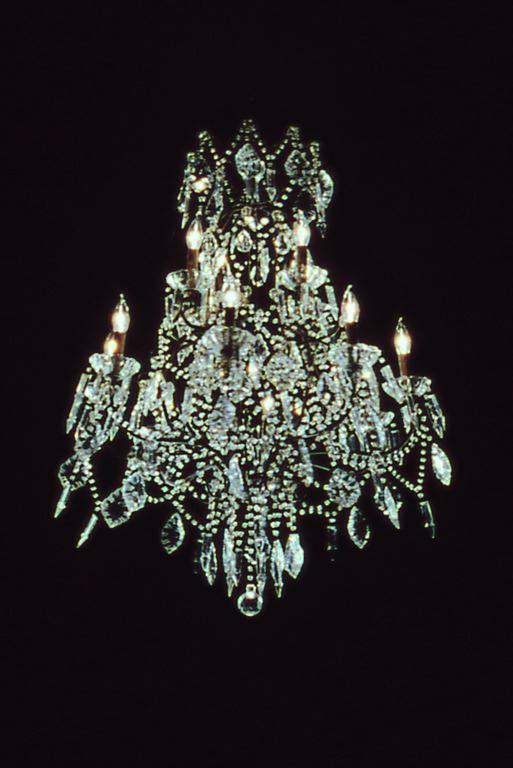Chandeliers, by definition, are excessive and opulent. At the Cosmopolitan in Las Vegas, for example, a multi-storey structure called the Chandelier, said to be composed of 2 million luminous crystals, houses three bars. (If the hotel website can be trusted, it is “a bit of playground, art exhibit and cocktail haven all at once.”) The light fixture depicted in Rodney Graham’s 35mm film Torqued Chandelier Release (2005) resides somewhere on the luminous spectrum between the larger-than-life fixture on the Vegas Strip and the economy chandeliers that surface at yard sales and cheap motels.
The projection, which plays in a 5-minute loop, focuses exclusively on a chandelier which twists and turns: it moves quickly at first and gradually slows until it comes to a near standstill. At that point, the light fixture—which is set in front of a black background that may evoke some of John Currin’s nudes—begins twirling again. When it spins at its fastest, the chandelier resembles a ballet dancer with tutu aflutter; as it slows down, viewers get a closer look at the ways it glistens.
Although the wall text at the Art Institute of Chicago, where the Vancouver-based artist’s Torqued Chandelier is part of the collection and is currently on exhibit, identifies the work as a “silent” film, the loud humming of the custom-made projector—one of four in the world made by the German manufacturer Kinoton—more than makes up for the lack of sound.
When one first enters Gallery 186 on the ground floor of the museum’s Modern Wing, the room seems pitch-black. But as one’s eyes acclimate, one makes out the fascinating and anachronistic sculpture that is the Kinoton projector—with its illuminated red and yellow buttons, and its film strip. Although the exhibition’s wall text identifies the film speed as 48 frames per second, the number 49 appeared conspicuously on the front of the machine during my visit. (A museum spokesperson states that the projector has since been fixed to run at 48 fps.)
The projected chandelier, which is centred on the screen, seems to defy gravity and to soar despite its weight, almost like Marc Chagall’s flying lovers. The chandelier hangs from a rope, but it is difficult to make out that apparatus, so it appears the chandelier is suspended in mid-air.
The film, which is the third of a trio, also has a lot to do with light. Graham has referred to the series as “illustrated ‘thought experiments’ documenting transitory lighting events within the context of a single roll of film,” according to an Art Institute of Chicago text, which adds that the chandelier film was inspired by Sir Isaac Newton’s experiment with a rotating water bucket.
Graham clearly didn’t intend it, but it is noteworthy that (until May 21) many viewers enter the chandelier installation from another temporary exhibition—namely, one featuring photographer Irving Penn’s series Underfoot. Just as the Manhattan–based photographer Penn (1917–2009) achieved surprisingly beautiful effects by training his lens on the cigarette butts and gum that New Yorkers trampled on city streets, Graham’s work, too, celebrates the majesty of the everyday.
With the exception of chandeliers that cannot be ignored, such as the three-storey one in Vegas, it is easy to take light fixtures for granted. It takes training a camera on a spinning chandelier, watching it twist one way and then the other way, and seeing it finally slow down to a stop to appreciate the almost impressionistic way that light dances across the crystals. The film surely owes a lot to Newton and to the laws of physics, but it is also part of a tradition that ought to be traced back to Monet.

 Rodney Graham Torqued Chandelier Release 2005 Courtesy Art Institute of Chicago © Rodney Graham
Rodney Graham Torqued Chandelier Release 2005 Courtesy Art Institute of Chicago © Rodney Graham







